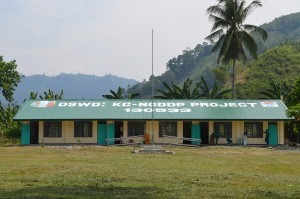MAITUM, Sarangani—T’boli children of Kalaneg village have now another reason of going to school comes class opening this June.
A newly-completed school building is awaiting pupils of Lomutan Elementary School after Department of Social Welfare and Development has turned over it to the community recently.
Bai Zorahayda T. Taha, DSWD-12 regional director said on Tuesday that the school building project is an answer to the education pressing need of the community, which old and dilapidated classrooms are found to be unsafe for children, majority from T’boli tribe.
“The new classrooms will surely make a difference in the learning process of children,” Taha said in a statement.
Taha added that the three-classroom project in Kalaneg is worth P2.66 million with the financial support from World Bank and constructed through the agency’s community-driven development (CDD) program, Kalahi-CIDSS.
Kalaneg’s school building is one of the 190 various community projects carried out under Kalahi-CIDSS in Region 12 after being scaled up as a national strategy for poverty-reduction, Taha said.
Prior to its completion, high ranking World Bank officials paid a visit in the community as part of the 4th Kalahi-CIDSS implementation support mission in the country, looking into the progress of its implementation.
The community was recognized, headed by Barangay Captain Gary Lee Perrett, for providing vehicle for free to fetch school children from their homes to school and vice versa, starting last year.
“Aside from the condition of our classrooms, distance is one of the major factors of the decreasing number of enrollment year after year,” Perrett said.
According to Perrett, many school children used to cut their classes in the afternoon and started to hike back to their homes.
With the new classrooms and free transportation, Perrett added that it will be of great help in encouraging the villagers to bring their children back to school.
Meanwhile, Tyron Jann Villanueva, area coordinator in Maitum said that the town is completing a total P14.49 million various projects including schools, health stations and a bridge.
Under the program, according to Villanueva, the town is now implementing the “Makamasang Tugon” phase, an LGU-led implementation designed to sustain the gains and lessons learned in the implementation of Kalahi-CIDSS by adopting the CDD as a strategy.
Kalahi-CIDSS, which stands for Kapit-Bisig Laban sa Kahirapan-A Comprehensive and Integrated Delivery of Social Services, is one of the three core programs of DSWD.
The said program aims to empower poor and disaster-affected communities to improve access to services by participating in a more inclusive local planning, budgeting, and implementation and in the overall affairs of the government.### (Hilbert T. Estacion, regional social marketing officer)

